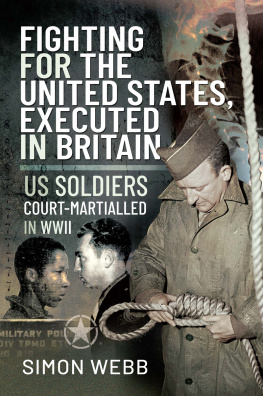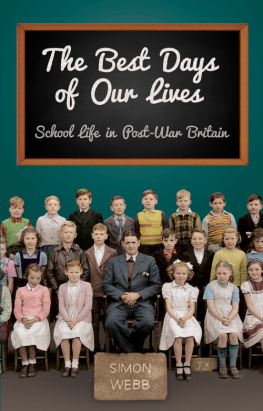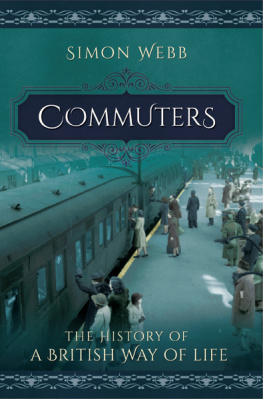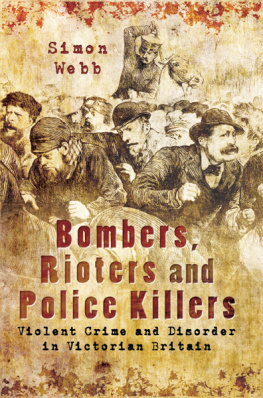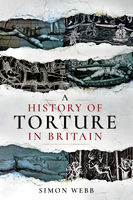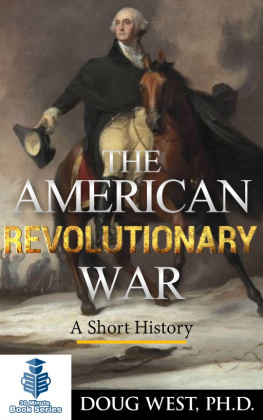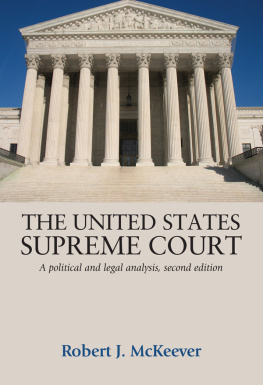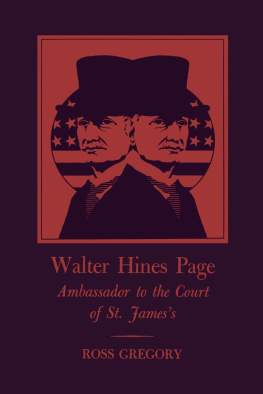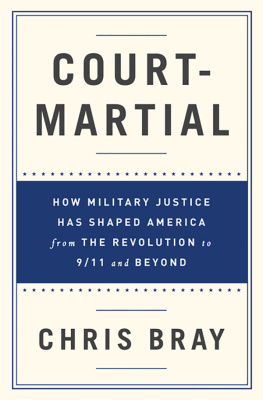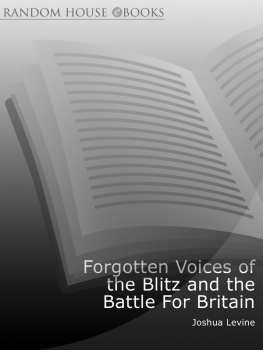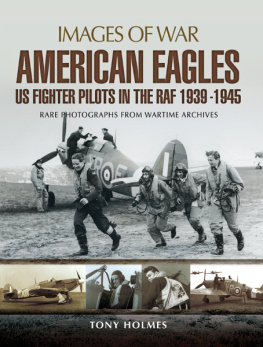Pagebreaks of the print version

Fighting for the United States, Executed in Britain
Fighting for the United States, Executed in Britain
US Soldiers Court-Martialled in WWII
Simon Webb
First published in Great Britain in 2021 by
Pen & Sword Military
An imprint of
Pen & Sword Books Ltd
Yorkshire - Philadelphia
Copyright Simon Webb, 2021
ISBN 978 1 52679 095 8
eISBN 978 1 52679 096 5
Mobi ISBN 978 1 52679 097 2
The right of Simon Webb to be identified as the Author of this work has been asserted by him in accordance with the Copyright, Designs and Patents Act 1988.
A CIP catalogue record for this book is available from the British Library.
All rights reserved. No part of this book may be reproduced or transmitted in any form or by any means, electronic or mechanical including photocopying, recording or by any information storage and retrieval system, without permission from the Publisher in writing.
Pen & Sword Books Ltd incorporates the Imprints of Pen & Sword Archaeology, Atlas, Aviation, Battleground, Discovery, Family History, History, Maritime, Military, Naval, Politics, Railways, Select, Transport, True Crime, Fiction, Frontline Books, Leo Cooper, Praetorian Press, Seaforth Publishing, Wharncliffe and White Owl.
For a complete list of Pen & Sword titles please contact
PEN & SWORD BOOKS LIMITED
47 Church Street, Barnsley, South Yorkshire, S70 2AS, England
E-mail:
Website: www.pen-and-sword.co.uk
or
PEN AND SWORD BOOKS
1950 Lawrence Rd, Havertown, PA 19083, USA
E-mail:
Website: www.penandswordbooks.com
List of Illustrations
Thomas Jefferson, the founding father of America whose policies affected the treatment of American soldiers in Britain during the Second World War.
A section of seventeenth-century stonework at Shepton Mallet Prison.
The execution of the conspirators involved in Abraham Lincolns assassination.
An X-ray of the so-called hangmans fracture.
The cowboy coil noose favoured by American executioners.
The free-running noose used in British hangings of the twentieth century.
The table of drops used to calculate the distance the prisoner should fall in British executions.
The new execution building constructed by the Americans when they took over Shepton Mallet Prison in 1942.
The cramped execution chamber; the railings mark the spot where the trapdoor once was.
The remains of the hinges of the trapdoors, still visible on the rafters below the modern floorboards.
Thomas Pierrepoint; by the time he undertook the executions of American soldiers, he was in his seventies.
Albert Pierrepoint, Thomas Pierrepoints nephew and his assistant at most of the hangings carried out at Shepton Mallet.
Lee Davis, the first man to be executed for rape in Britain for over a century.
William Harrison, who committed one of the worst crimes seen in Britain during the Second World War.
A newspaper article about the court martial of Leroy Henry.
The wall in Shepton Mallet Prison where two men were executed by firing squad.
Sir Eric Teichman, the British diplomat who died when he went to investigate a suspected poacher.
Honingham Hall, the palatial home of Sir Eric Teichman at the time of his murder.
Master-Sergeant John C. Woods, the American Armys executioner in Europe.
Plot E at the Oise-Aisne American Cemetery and Memorial in France, where the bodies of the soldiers executed at Shepton Mallet now lie.
Introduction
I n January 1942 the first American forces arrived in Britain to join the fight against Nazi Germany. A month earlier, the surprise attack on their naval base at Pearl Harbor had precipitated the involvement of the United States in what was now a world war. Shortly after the Japanese assault on Pearl Harbor, Germany declared war on America, with the result that America and Britain became allies, fighting for the liberation of Europe. Between 1942 and 1945, the year that the Second World War ended, a total of ninety-six American servicemen were executed after being tried by courts martial, eighty-nine by hanging and seven by firing squads. Of these men, eighteen were executed in England. Another American soldier, Karl Hulten, was hanged in Londons Pentonville Prison after a trial in a British court; the rest were executed at Shepton Mallet Prison, in the English county of Somerset. This, the oldest prison in England, had been provided to the US Army as a disciplinary establishment.
A peculiarity of the hangings carried out at Shepton Mallet when it was under the control of the United States was that they were all undertaken by British executioners, the British government having forbidden the US Army from hanging anybody in their country. There was no objection to firing squads, but executions by hanging had to be conducted by the British themselves. This was odd, because the armed forces of the United States were in all other respects quite literally a law unto themselves. An Act of Parliament was passed which prevented any American soldier from being prosecuted in the United Kingdom for any crime at all, including murder, unless the agreement of the United States government had been obtained. Despite having given America and its armed forces freedom from the law of the land and allowing them to run their own affairs precisely as they wished, why should Britain stand resolute and inflexible on this one, relatively insignificant point? How could the nationality of the man who operated the gallows by pulling a lever possibly matter that much? To answer that question will require a detailed and lengthy examination of the process of judicial hanging.
It is no exaggeration to say that over the course of a century or so, the British had turned hanging people into an art. The aim, invariably achieved, was to snap the neck of the condemned man or woman cleanly, causing instant death. This was not a skill which the Americans had mastered and as late as 1930, a womans head was wrenched from her body during an execution in the United States, landing at the feet of the horrified witnesses. More common was the situation when no damage at all was done to the neck and the victim simply choked to death at the end of the rope, a process which could take up to half an hour. We shall be studying the development of judicial hanging in both Britain and the United States, to see why the British government were inflexible on this one point.
In this book we shall also be examining the strange circumstances which led to American soldiers in Britain being immune from prosecution. To do so, we must look in some detail at the origins of the United States and how the country came to have a mortal dread of treaties and formal alliances. It will also be necessary to address the uncomfortable fact that although only 10 per cent of the United States forces in Britain were black, the majority of those executed at Shepton Mallet were black or of Hispanic origin. To understand why that should have been the case, the application of the death penalty in the United States itself must be scrutinized. Finally, we will explore the personal histories of all the nineteen American soldiers executed in Britain following courts martial or, in the case of Karl Hulten, a criminal trial in a British court. Hultens case was the one exception to the rule above, that American soldiers committing crimes in Britain should be dealt with only by American courts martial, rather than the countrys ordinary judicial system. In February 1946 the magazine Tribune published an essay by George Orwell, who was of course later to achieve fame as the author of Nineteen Eighty-Four and Animal Farm . Orwells piece, entitled, Decline of the English Murder, was inspired by what became known as the Cleft Chin Murder. This killing was carried out by Karl Hulten and his teenage girlfriend and because it involved a British citizen facing a capital charge, the United States government agreed that the interests of justice would be better served if the pair were tried in a British court, the only occasion on which an American serviceman faced a British court during the Second World War.

